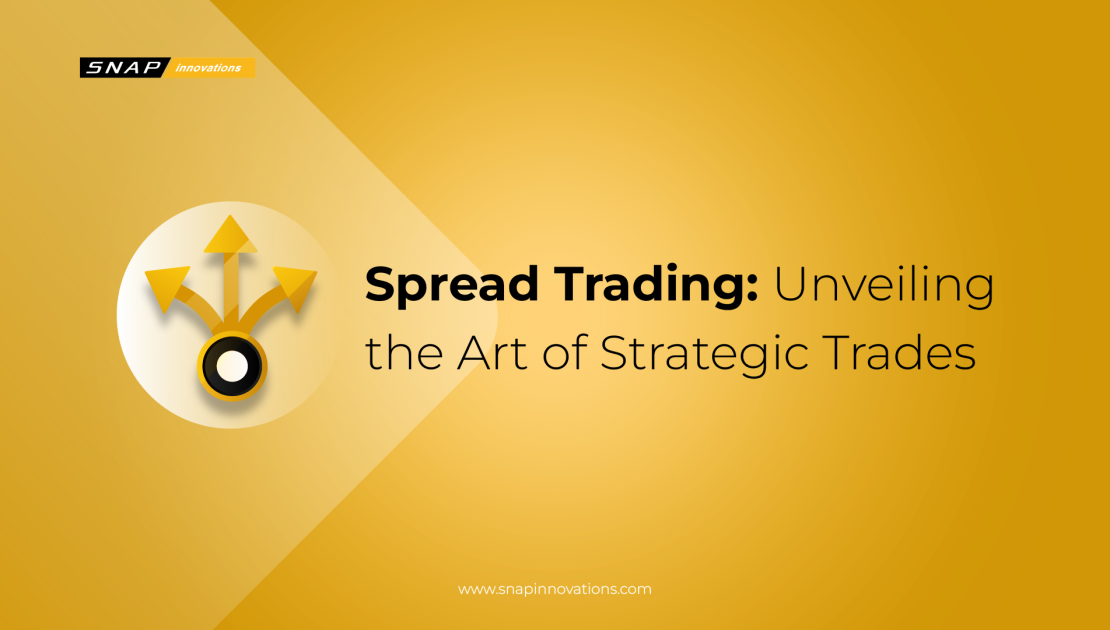Welcome to the world of spread trading, where art meets strategy, and success is measured by your ability to navigate the complex web of financial markets. Spread trading is more than just buying and selling assets; it’s a skillful dance that requires finesse, knowledge, and a dash of intuition. In this comprehensive guide, we will delve deep into the realm of spread trading, equipping you with the tools and insights needed to become a spread trader extraordinaire.
So, what exactly is a spread trader, and why is it an art form worth mastering? Let’s begin our journey by unraveling the basics.
What is a Spread Trader?
Spread trading, also known as relative value trading, is a strategy employed in financial markets. At its core, it involves simultaneously buying and selling related securities, with the goal of profiting from the price difference between them. These related securities can include stocks, options, futures, and more. The spread trader isn’t interested in the direction of the overall market; instead, they focus on the relative movements between the chosen assets.
Spread traders are often characterized by their ability to spot opportunities in markets with low volatility, as they rely on price differentials rather than price trends. The goal is to capture profits by betting on the relative outperformance or underperformance of one security against another within a pair or group of related assets.
Spread traders navigate through various financial markets, including stocks, commodities, forex, and derivatives, capitalizing on their diverse expertise and knowledge. Their versatility allows them to identify and seize lucrative trading opportunities across different market segments, providing a hedge against market-specific risks and volatility.
Spread Trading Strategies
 Now that we have a fundamental understanding of spread trading, let’s explore an expanded set of strategies that can help you excel in this field.
Now that we have a fundamental understanding of spread trading, let’s explore an expanded set of strategies that can help you excel in this field.
Spread trading offers a plethora of advantages that make it an appealing choice for traders seeking a unique approach to financial markets. Let’s delve deeper into these benefits:
1. Reduced Market Risk: Finding Stability in Volatility
One of the most significant advantages of spread trading is that it can be inherently market-neutral. In traditional trading, investors often face substantial risk when markets experience extreme volatility or sudden reversals.
However, spread trading’s focus on relative price movements can provide a shield against such market turbulence. Whether the broader market is bullish or bearish, spread traders aim to capitalize on the relative strength or weakness of specific assets within their chosen pairs or groups.
2. Lower Margin Requirements: Scaling Your Risk
Compared to traditional directional trading, spread trading often requires lower margin requirements. This can be a game-changer for traders looking to scale their positions without tying up excessive capital.
Lower margin requirements mean you can deploy your resources more efficiently, potentially taking advantage of multiple spread opportunities simultaneously.
3. Diversification: The Art of Balance
Diversification is a core principle of risk management, and spread trading offers a unique way to achieve it. By simultaneously trading multiple related assets, spread traders can spread risk across different sectors or asset classes.
Read more: Due Diligence: Protecting Your Investments
For instance, you might trade spreads in commodities, equities, and currencies, diversifying your exposure while maintaining a relative value approach. This diversification can help spread traders manage risk more effectively and reduce the impact of adverse market movements in a single asset.
4. Enhanced Risk-Reward Profiles: Capturing Market Inefficiencies
Spread trading often targets market inefficiencies or mispricings, which can lead to attractive risk-reward profiles.
When a spread trader identifies a pair of related assets with a significant price disparity, there is an opportunity to profit as the prices converge or diverge. This can result in favorable risk-reward ratios, where potential gains outweigh potential losses.
5. Consistent Income Streams: Income Generation Strategies
Some spread trading strategies, such as options spreads or calendar spreads, can be structured to generate consistent income streams.
Traders can profit from time decay, volatility, or the stability of relative price movements. This income generation aspect can be particularly appealing to those seeking an additional source of regular income or aiming to build a steady trading portfolio.
6. Flexibility and Adaptability: Adapting to Market Conditions
Spread trading’s flexibility is another significant advantage. It allows traders to adapt to various market conditions. In volatile markets, they can focus on capturing price disparities, while in calmer markets, they may shift their strategy to profit from steady convergence or divergence.
This adaptability enables spread traders to navigate changing economic landscapes with confidence.
7. Lower Transaction Costs: Efficiency in Trading
Transaction costs, such as commissions and spreads, can eat into profits for traders. Spread trading often involves fewer trades compared to day trading or high-frequency trading.
Fewer trades mean lower transaction costs, which can contribute to improved overall profitability.
8. Reduced Emotional Stress: Logic Over Emotion
Emotions can play a significant role in trading decisions. Spread trading, with its systematic approach based on relative value analysis, tends to be less emotionally charged than directional trading.
Traders focus on data, analysis, and predefined strategies rather than getting caught up in the emotional rollercoaster of market sentiment.
In conclusion, spread trading is a powerful and versatile approach that offers numerous benefits to traders. Whether you are seeking reduced market risk, enhanced risk-reward ratios, or a more systematic and less emotional trading experience, spread trading provides a unique avenue for achieving your financial goals. However, like any trading strategy, success requires dedication, continuous learning, and discipline. So, embrace the art of spread trading and explore the opportunities it offers in the ever-evolving world of financial markets.
Tools and Resources for Spread Traders
 To excel in the world of spread trading, you need more than just knowledge and a trading platform. You need a well-equipped toolkit and access to valuable resources. Here, we’ll explore additional tools and resources that can empower spread traders on their journey to success:
To excel in the world of spread trading, you need more than just knowledge and a trading platform. You need a well-equipped toolkit and access to valuable resources. Here, we’ll explore additional tools and resources that can empower spread traders on their journey to success:
1. Risk Management Software: Safeguarding Your Art
Effective risk management is the bedrock of successful trading. Specialized risk management software can help spread traders calculate and implement risk-reward ratios, set stop-loss orders, and establish position sizing strategies.
These tools are crucial for preserving your capital and preventing significant losses during adverse market conditions. By utilizing risk management software, you can ensure that each trade aligns with your overall risk tolerance and trading plan.
2. Market Scanners and Screeners: Uncovering Opportunities
Market scanners and screeners are indispensable tools for spread traders looking to identify potential opportunities. These software applications allow you to filter and screen assets based on specific criteria.
For example, you can scan for assets with high correlation or those exhibiting recent price divergences. Market scanners and screeners streamline the process of narrowing down your watchlist and help you focus on assets that align with your trading strategy.
3. Algorithmic Trading Platforms: Automated Precision
Algorithmic trading platforms provide an advanced option for spread traders. These platforms enable you to automate your trading strategies based on predefined rules and algorithms.
Algorithmic trading can enhance efficiency, execution speed, and consistency in your trading activities. It also allows you to execute trades across various markets and assets simultaneously, further leveraging the benefits of spread trading.
4. Economic Calendars and News Aggregators: Staying Informed
In the financial markets, information is power. Economic calendars and news aggregators provide real-time updates on economic events, corporate earnings releases, geopolitical developments, and other factors that can impact the markets.
Staying informed about relevant news and events is crucial for spread traders as it helps them make informed decisions and adjust their strategies as needed.
5. Historical Data and Backtesting Tools: Learning from the Past
Understanding historical price movements and backtesting your trading strategies is essential for refining your approach.
Historical data sources and backtesting tools enable you to analyze past performance, test different strategies, and gain insights into how your trading methods would have performed under various market conditions. This data-driven approach can help you fine-tune your strategies and improve your overall trading performance.
6. Trading Journals and Analytics Platforms: Tracking Your Progress
Maintaining a trading journal is a habit often overlooked by traders but highly beneficial. A trading journal allows you to record your trades, emotions, and decisions. Over time, it helps you identify patterns in your trading behavior and assess the effectiveness of your strategies.
Many trading platforms and analytics tools offer built-in journaling features to make this process seamless.
7. Community and Forums: Learning from Others
Engaging with a community of fellow spread traders can provide valuable insights and support. Online forums, social media groups, and trading communities are excellent places to share experiences, ask questions, and learn from others.
These platforms can help you stay updated on the latest market trends, trading strategies, and best practices.
8. Mentors and Education Programs: Guided Learning
Consider seeking guidance from experienced spread traders or enrolling in structured education programs. Having a mentor can significantly accelerate your learning curve by providing personalized guidance and feedback.
Education programs, whether in the form of courses, webinars, or workshops, offer structured learning paths that cover everything from basic concepts to advanced strategies.
9. Tax and Accounting Tools: Managing Finances
Spread trading involves financial transactions that may have tax implications. Utilizing tax and accounting software or consulting with professionals can help you manage your trading-related finances efficiently. These tools can assist you in tracking gains and losses, calculating taxes, and ensuring compliance with tax regulations.
In conclusion, being a successful spread trader requires more than just trading skills; it demands a comprehensive approach that includes risk management, analysis, automation, and ongoing education. By leveraging these additional tools and resources, spread traders can enhance their trading capabilities, stay informed, and maintain a disciplined and organized trading routine. Ultimately, it’s the combination of knowledge, practice, and the right tools that can lead to mastery in the art of spread trading.
Developing a Spread Trading Plan
A comprehensive spread trading plan is pivotal for navigating the financial markets effectively, serving as your strategic blueprint for trading activities. Beginning with the clear articulation of your trading goals, the plan should mirror your financial aspirations, risk tolerance, and trading style.
Initiate your plan by outlining clear and measurable trading objectives. Whether you’re aiming for consistent short-term gains or building wealth over the long term, your goals should be specific, attainable, and time-bound. This clarity provides direction and purpose, steering your trading activities towards desired outcomes.
Understanding and defining your risk tolerance is crucial. Every trader has a different level of comfort with risk, and it’s vital to know yours. Acknowledging how much capital you’re willing to risk on individual trades and overall allows you to trade with confidence and safeguard your financial well-being.
Your trading plan should include a selection of trading strategies that align with your objectives and risk tolerance. Since the markets are dynamic, employing a combination of strategies provides flexibility. Test these strategies using historical data or paper trading before implementing them live, making necessary adjustments to improve efficacy and reduce risk.
Analyzing Spread Trading Opportunities
 A meticulous approach to analyzing spread trading opportunities is indispensable. Beyond understanding market dynamics, traders should also consider the macroeconomic environment, as factors such as interest rates, inflation rates, and economic growth can significantly impact asset prices.
A meticulous approach to analyzing spread trading opportunities is indispensable. Beyond understanding market dynamics, traders should also consider the macroeconomic environment, as factors such as interest rates, inflation rates, and economic growth can significantly impact asset prices.
Practicing vigilant risk management is also essential. By identifying potential risks associated with each trading opportunity and developing strategies to mitigate these risks, traders can protect their capital and improve their long-term profitability prospects.
Also Read: Defi Staking Platform Development: Key Steps and Considerations
And also Economic indicators play a pivotal role in market analysis. Factors like interest rates, employment figures, and GDP growth impact market movements significantly. Being attuned to these indicators allows spread traders to anticipate market shifts and make informed decisions, aligning their trading strategies with broader economic trends.
Analyzing spread trading opportunities is both an art and a science. It requires a blend of analytical rigor, intuitive understanding, and adaptability. By holistically approaching market analysis and staying informed and adaptable, spread traders can position themselves favorably to recognize and seize lucrative trading opportunities as they arise.
Conclusion
Becoming a master spread trader is a journey that combines art, strategy, and discipline. By understanding the fundamentals of spread trading and mastering a range of strategies, you can embark on a path to financial success. Remember, patience and continuous learning are the keys to mastering the art of spread trading. So, start your journey today, and may your spreads always be in your favor!

